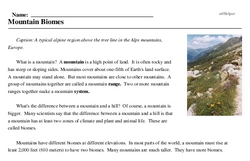Mountain Biomes
Caption: A typical alpine region above the tree line in the Alps mountains, Europe.
What is a mountain? A mountain is a high point of land. It is often rocky and has steep or sloping sides. Mountains cover about one-fifth of Earth's land surface. A mountain may stand alone. But most mountains are close to other mountains. A group of mountains together are called a mountain range. Two or more mountain ranges together make a mountain system.
What's the difference between a mountain and a hill? Of course, a mountain is bigger. Many scientists say that the difference between a mountain and a hill is that a mountain has at least two zones of climate and plant and animal life. These are called biomes.
Mountains have different biomes at different elevations. In most parts of the world, a mountain must rise at least 2,000 feet (610 meters) to have two biomes. Many mountains are much taller. They have more biomes.
Remember that a biome is a community of plants and animals that live together in a region. They depend on each other. Deserts, grasslands, and rainforests are some examples of biomes.




